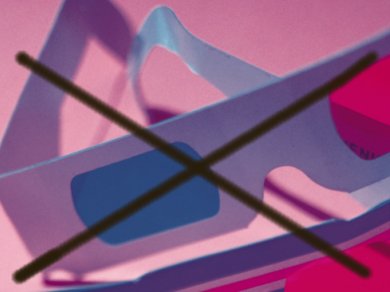Holography Vs Polarization
Current 3D imaging techniques such as those used in cinemas and television are based on polarization technology. This requires the recording of two individual streams of data from cameras set up side-by-side and separated by the same distance as a person’s pupils. For viewing, the images are recombined by superposition and polarized glasses ensure that each eye receives the same image from different perspectives, creating the illusion of depth.
Holography, however, allows a viewer to observe light as if it has been directly scattered by the real object, without the need for special eyewear. It does this by reconstructing both the intensity and wave front information obtained from a scene. This requires a large amount of data, which means that holography has, so far, been limited to science-fiction due to insufficient computer power. The other problem has been the lack of display media large enough and fast enough to display and update the holographic image for realistic projection.
New Polymer Display
Nasser Peyghambarian and co-workers, University of Arizona, USA, recently reported a quasi-real-time holographic display that can refresh images every two seconds. The key to the fast refresh rate is in the material for the recording medium the team have developed — a sensitized photorefractive polymer. It consists of a polyacrylic backbone with tetraphenyldiaminobiphenyl (TPD) and carbaldehyde aniline (CAAN) pendant groups attached in the ratio 10:1 (TPD/CAAN). To lower the glass transition temperature and to facilitate chromophore alignment, a plasticizer and fluorinated dicyanostyrene chromophore were added. Finally, the material was doped with the fullerene derivative, [6,6]-phenyl-C61-butyric acid methyl ester, to sensitize the material to the pulse of the laser.
An array of cameras was used to capture the image of an object from multiple angles. This information was then coded onto a laser beam. By using nanosecond pulses of a laser with a repetition rate of 50 Hz, holographic pixels (hogels) were recorded on the polymer. Each 6-ns pulse recorded an individual hogel. This meant that the writing time was reduced by several orders of magnitude. A 4 inch × 4 inch (10 cm x 10 cm) sample could be recorded in about 2 s, with 1-mm hogel resolution. The previous rewritable display created by this group required a second per hogel and an erase time of 1 min before the image could be refreshed. A 4 inch × 4 inch (10 cm x 10 cm) sample would, in this case, take a total of 4 min to record.
The information from the camera array can be processed using a general-purpose desktop PC and transmitted via an Ethernet link, removing the need for extensive computing power.
Potential Uses
Peyghambarian can see many uses for this technology and envisions its applications to daily life: “Let’s say I want to give a presentation in New York. All I need is an array of cameras here in my Tucson office and a fast Internet connection. At the other end, in New York, there would be the 3D display using our laser system. Everything is fully automated and controlled by computer. As the image signals are transmitted, the lasers inscribe them into the screen and render them into a three-dimensional projection of me speaking.”
- Holographic three-dimensional telepresence using large-area photorefractive polymer
P.-A. Blanche, A. Bablumian, R. Voorakaranam, C. Christenson, W. Lin et al.,
Nature 2010, 468, 80–83.
DOI: 10.1038/nature09521




